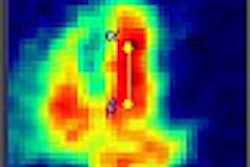In patients with equivocal radionuclide stress test results, electron-beam CT could be the back-up modality of choice for diagnosing obstructive coronary artery disease, particularly because of its prognostic power. Ideally, imaging experts will utilize both in order to obtain the best information, according to cardiologist Dr. Alan Guerci, president of St. Francis Hospital in Roslyn, NY.
Guerci made his remarks at the 2002 American Society of Nuclear Cardiology meeting in Baltimore, during a session that looked at the potential merits, and demerits, of non-nuclear imaging modalities.
In Guerci’s estimation, it doesn’t have to be an either/or prospect: For those whose stress results are equivocal -- especially those without symptoms -- a follow-up EBCT scan can offer the most complete patient profile.
Guerci noted that the two tests offered fundamentally different information about a patient: The EBCT gives an estimate of coronary calcium, which can be used to assess risk. SPECT offers information about myocardial perfusion, as well as assessing defects that can indicate the likelihood of future coronary events.
The prognostic power of EBCT comes from calcium scoring. Only about 2% of patients with obstructive coronary disease have a calcium score of zero, making the absence of calcium a powerful sign for dismissing a diagnosis of coronary artery disease. The problem, however, is that the test has poor specificity, making it difficult to separate false positives from true positives.
Still, evidence suggests that EBCT is at least as accurate as radionuclide stress testing for the diagnosis of obstructive coronary artery disease. Guerci focused on three published studies that compare EBCT to radionuclide stress testing.
A 1995 study by Dr. Kouji Kajinami and colleagues at Kanazawa University in Japan followed 251 patients who underwent EBCT, electrocardiographic (ECG), and thallium exercise tests.
They found that "the calcification scores of patients with significant stenosis in at least one vessel were significantly higher than those of patients without significant stenosis in the study group as a whole and in most patient subgroups classified according to age and gender. The difference in specificity between calcification scores and ECG exercise test results had borderline significance (p = 0.058) and that between calcification scores and thallium test results was significant (p = 0.001)," they wrote (Journal of the American College of Cardiology, November 1, 1995, Vol.26:5, pp. 1209-1221).
The results suggest that EBCT is no worse -- and possibly more accurate -- than SPECT scanning at predicting atherosclerosis, Guerci said.
Another study, by Dr. Alex Schmermund and colleagues at the Mayo Clinic in Rochester, MN, found that coronary calcium "predicts the angiographic extent of CAD in symptomatic patients and provides independent and incremental information to the more conventional clinical parameters derived from SPECT or risk assessment." This study followed 291 patients who had EBCT scans and 136 patients who underwent SPECT scans (Journal of the American College of Cardiology, September 1999, Vol.34:3, pp. 777-786).
Finally, Dr. David Shavelle and colleagues from Saint John's Cardiovascular Research Center in Torrance, CA, demonstrated that EBCT had a "higher diagnostic ability than either treadmill-ECG or technetium-stress for the detection of obstructive angiographic CAD." They also found that adding a treadmill test to EBCT could boost the specificity to 83% from 47% percent for EBCT alone (Journal of the American College of Cardiology, July 2000, Vol.36:1, pp. 32-38).
Guerci’s position that EBCT and stress testing work best together was echoed by Dr. Robert Hendel, the director of nuclear cardiology at Rush-Presbyterian-St. Luke’s Medical Center in Chicago. Hendel said that EBCT was a useful tool to generate an "initial impression" when evaluating patients, especially asymptomatic ones.
By Brian ReidAuntMinnie.com contributing writer
October 21, 2002
Related Reading
High calcium scores linked to dramatic increase in coronary event risk, January 24, 2002
Coronary calcium, C-reactive protein predict cardiovascular event, October 3, 2002
High coronary calcium level predicts progression of arterial calcification, July 2, 2002
Copyright © 2002 AuntMinnie.com




















